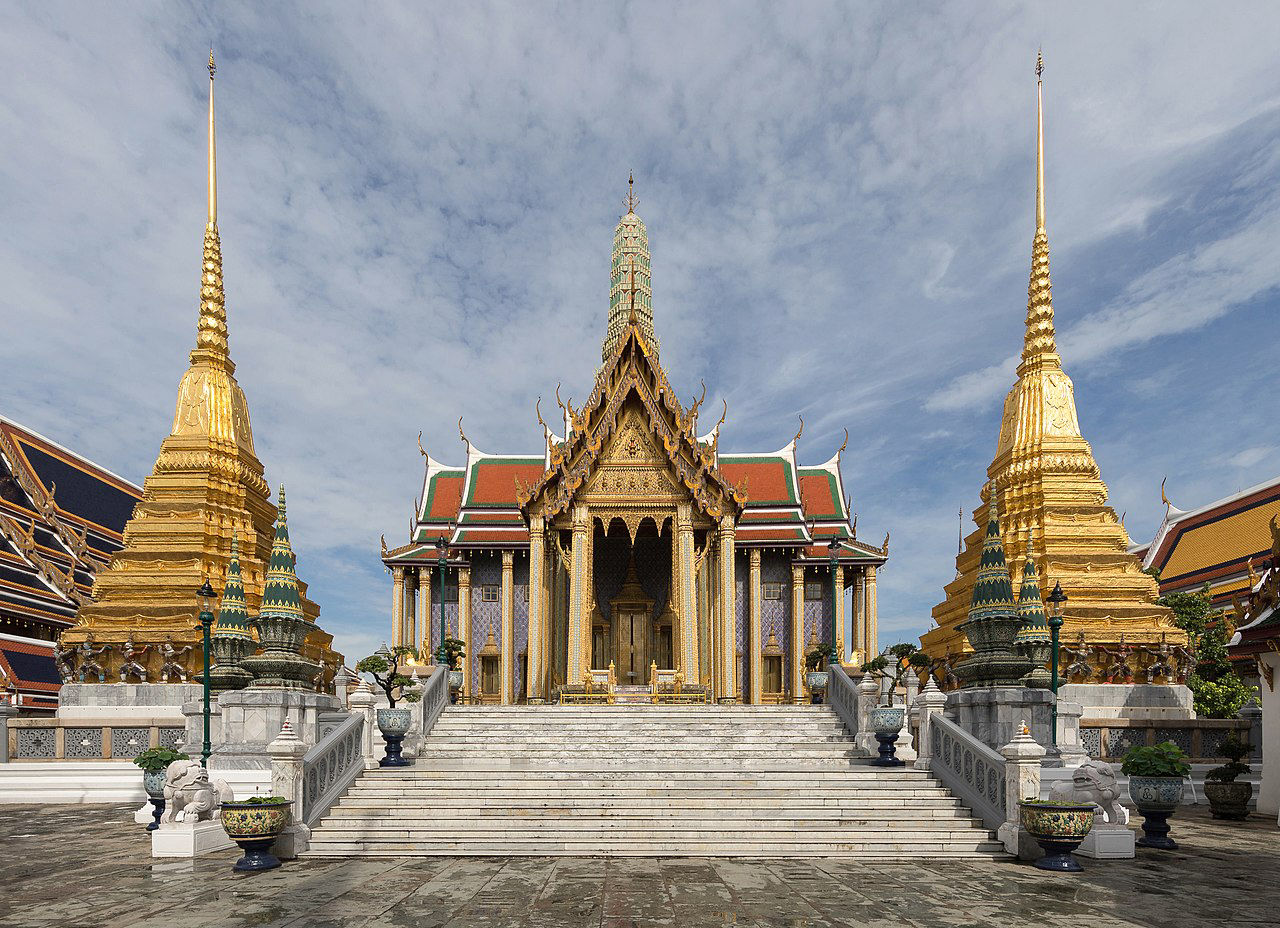
Travel Guides & Information

The Grand Palace & Wat Pho
If you could only choose one thing to do during your visit to Bangkok, seeing the Grand Palace should be it. Built in 1782, the palace was commissioned by then-king Rama I, who founded Thailand's Chakri Dynasty.
During the centuries since it was first built, the palace grounds have been well maintained, with particular care being taken to preserve and restore the palace's extensive murals. Thailand's most sacred site, the Emerald Buddha temple, is located between the walls of the palace, and so are many other important buildings where you can get a chance to experience a piece of Thailand's history firsthand.
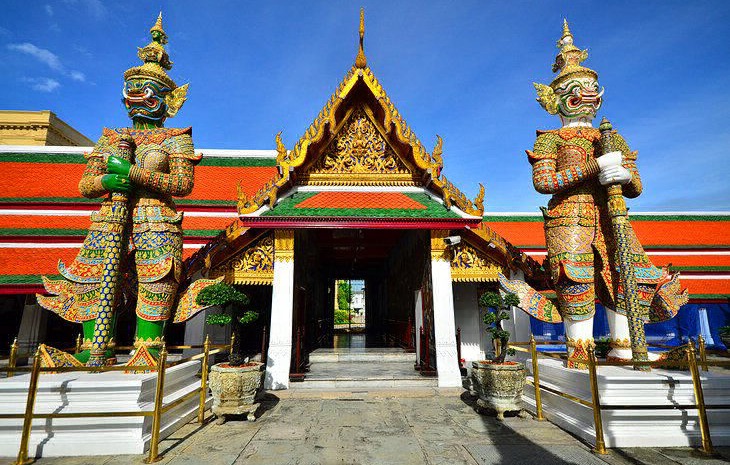
Wat Phra Kaeo
Temple of the Emerald Buddha
This holy site is easily recognizable by the two imposing demon figures guarding the entrance. The statues, gifts from Chinese merchants, stand sentinel at the gate to the gorgeous temple. Those brave enough to pass by the demons are treated to a cycle of murals depicting the epic poem of Ramakien, which recounts the work of the gods and their relationship with humanity. Inside the gold-tiled chedi, known as Phra Si Ratana, there's a relic that (according to tradition) its either a piece of bone or hair of the enlightened Buddha.
Inside the bot, the exquisite statue of a meditating Buddha—made completely out of the semi-precious stone jade and dressed in gold robes—stands just 66 centimeters high and rests on a tall plinth beneath a nine-tiered canopy. Scholars believe the figure was carved in Pataliputra in India, though other sources claim it to be from Burma and the work of an unknown artist. It first came to light in 1434 in Chiang Rai, northern Thailand, having arrived there by way of Ceylon (now Sri Lanka) and Cambodia.
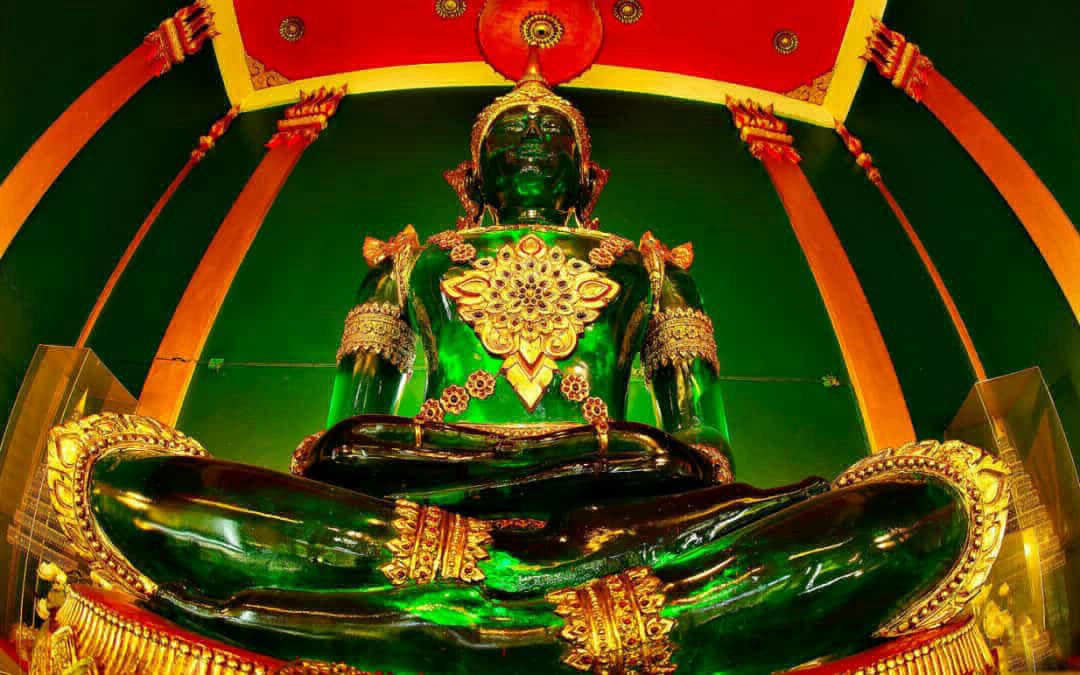
The Emerald Buddha
At the time of its discovery, the statue was encased in plaster. While being transported, the casing was damaged and split open, revealing the figure within. The Buddha traveled a long way to end up in Bangkok in 1778, where it has been kept ever since. Three times a year, the king changes the Buddha's robes during a special ceremony to mark the beginning of a new season.
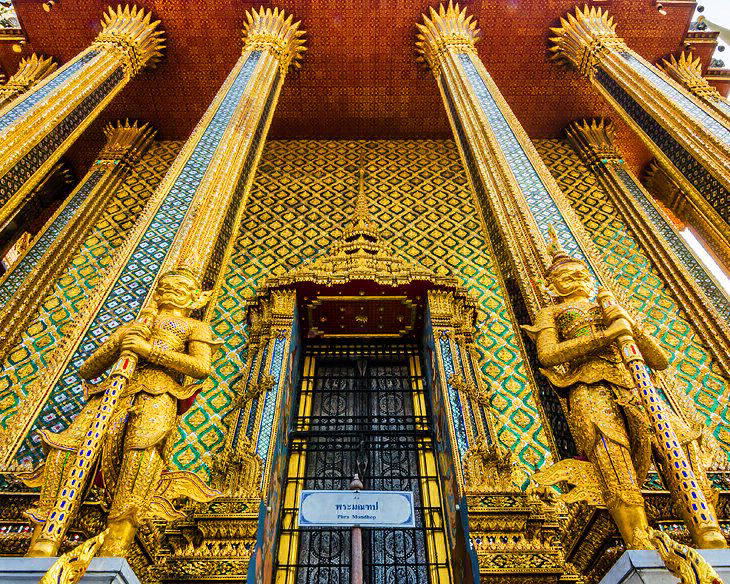
Phra Mondop
Behind Phra Sri Ratana is Phra Mondop—a building made out of tiny green and gold glass mosaics, a gilt spire, and pure silver floors—which serves as the Palace library. This golden building holds the Canon of Buddha—sacred scriptures written on palm leaf—as well as a number of Buddhist publications and ancient literature.
While the building remains closed to the public, and you won't be able to get even a peek of the sacred texts, the outside sight of the beautiful mother-of-pearl doors, dragon imagery, and Ayutthaya-style architecture are more than worth a stop.
Ho Phra Parit
Originally, this unique hall was created especially for the use of monks, who would congregate here daily to create Holy water and then sprinkle it all around the palace. During times of war, the water was also used to "enhance" the power of weapons through a special ceremony performed here. While the practice of creating Holy water was discontinued in the 1920s, the ceremony is still performed during Buddhist holy days.
Ho Phra Parit is divided into two rooms, with the largest one being used for prayers and rituals, and the smaller one used as a storage space for religious artifacts.
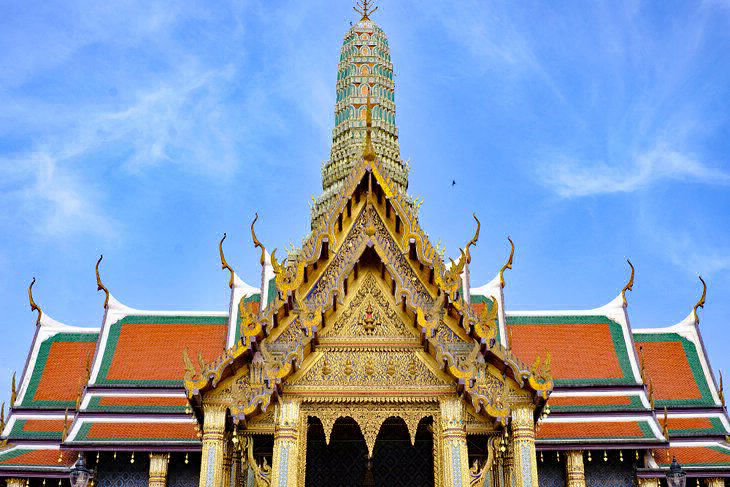
Prasat Phra Debidorn
The Prasat Phra Debidorn building, also known as the Royal Pantheon, contains life-size statues of the kings of the Chakri dynasty. The building was originally designed to house the Emerald Buddha, but those plans were abandoned when the resulting construction was deemed too small.
Catching a glimpse of the kings will be tricky, though—the interior is only open to the general public once a year, on Chakri Day (April 6). Fortunately, the outside of the pantheon is equally famous thanks to the two golden pagodas and the row of colorful, larger-than-life demons who guard the building and make for popular photo backgrounds.
Angkor Wat Replica
While nothing beats the magnificence of the real Angkor Wat in Cambodia, this perfect replica of the Khmer-style temple is worth visiting. Although much smaller than the real thing, the stone model does offer an interesting history lesson and a glimpse at the landmark as it was being planned. The model dates from the reign of Rama IV, when what is now Cambodia was a vassal state of Siam.
The mini Angkor Wat is right across from the Emerald Buddha temple, and you can easily miss it if you're not looking for it. Surrounded by colorful, ornate buildings, the simple design of this gray sand model offers a noticeable contrast worth a look.
Boromabiman Hall
Boromabiman Hall is the official name for the building that overlooks the lawns where the king's annual garden party used to be held. Frescos inside depict the four Indian gods (Indra, Yahuma, Varuna, and Agni) as guardians of the universe. Inscribed on plaques beneath are the ten royal virtues: liberality, propriety, readiness to make sacrifices, clemency, modesty, conscientiousness, freedom from anger, freedom from suspicion, patience and right dealing.
Ever since the time of Rama VI, all the Crown Princes have grown up here. Nowadays the building is only used occasionally, usually to accommodate visiting heads of state or high-ranking Buddhist dignitaries.
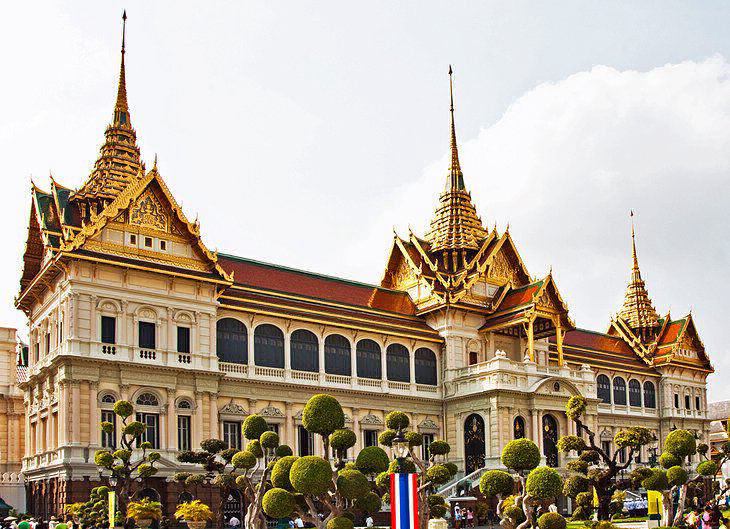
The Great Chakri Palace
Though it is no longer the royal residence (the present monarch, King Maha Vajiralongkorn, lives at the Amphorn Sathan Residential Hall inside Bangkok's Dusit Palace since 2016, when he inherited the throne after the death of his father), the Great Chakri Palace is still something special to behold.
The residence was originally designed by an English architect in Italian Renaissance style, but King Rama V ordered that it be embellished with typically Siamese stepped roofs and mondhop. While the design makes the building stand out from the ones around it, it also makes it seem more royal and important. As well as being notable for the richness of their interiors, all the rooms in the palace are treasure troves with valuable paintings and portraits of every Thai king.
Phra Thinang Amarin Winitchai
This is the "High Residence"—essentially a throne room where King Rama I once received homage. The hall is still used today, often in ceremonies involving heads of state or for future anniversary celebrations of the present king's coronation. You can see a peristyle in front of the building, which is where royal proclamations used to be read.
Inside, the golden throne, shaped like a boat, takes center stage. Right in front of it, there's a giant, royal, nine-tiered umbrella, which represents the king's prestige and power. Royal umbrellas can have anywhere from five tiers (for a crown prince) to nine for a sovereign king.
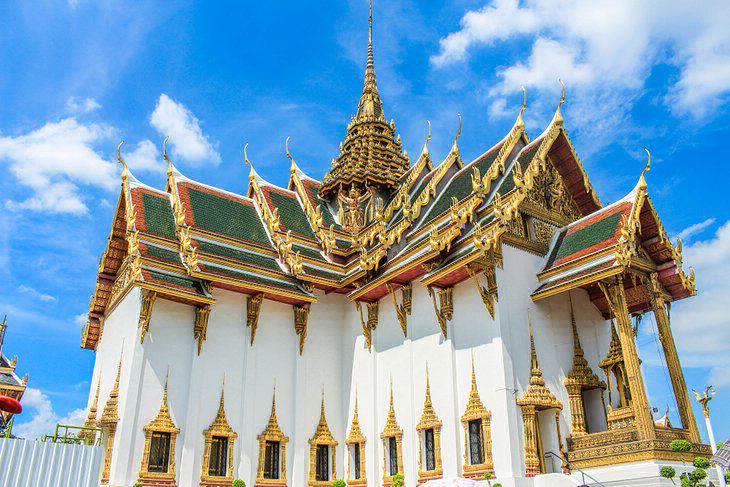
Dusit Maha Prasat
The single large inner hall of this building, which is open to visitors, was originally Rama I's Audience Chamber. Here, the king received his guests, seated not on the large throne seen today, but higher up on a niche-like throne set in the south wing wall. On the roof, a spire designed to look like the king's crown adds a royal touch to this Italian Renaissance meets Thai traditional hall.
While the furniture inside is original to the time of the building's construction, the murals were painted in a later period. There's also a second mother-of-pearl inlaid throne here, which was used by the king when he stepped away or took a break between audiences.
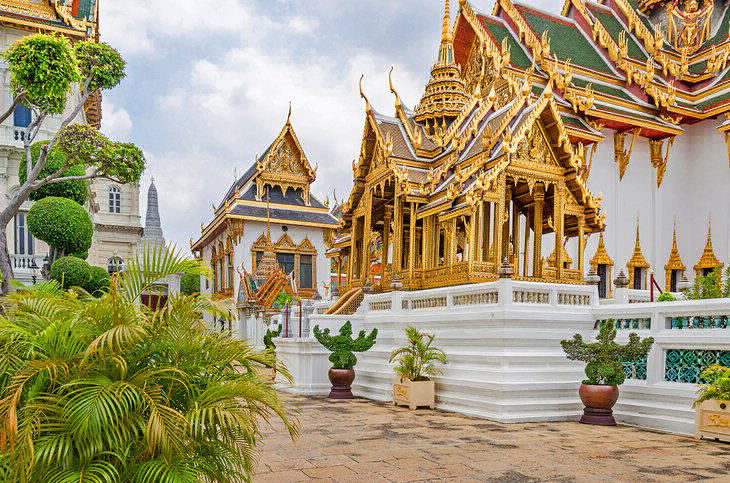
Aphorn Phimok Prasat
When leaving the Dusit Maha Prasat, the delicate golden wooden pavilion ahead is the Aphorn Phimok Prasat, used by Rama I as a robing chamber. Here, the king would change before entering the audience room and then again after leaving. Drapes interlaced with gold thread were drawn around the pavilion pillars while the king donned his ceremonial robes.
This pavilion was also used to park the king's palanquin, a one-passenger human-powered form of transport—basically a large box or seat carried by six bearers on long poles. Before a ceremony, the king would change inside Dusit Maha Prasat before leaving in the palanquin to join the festivities.
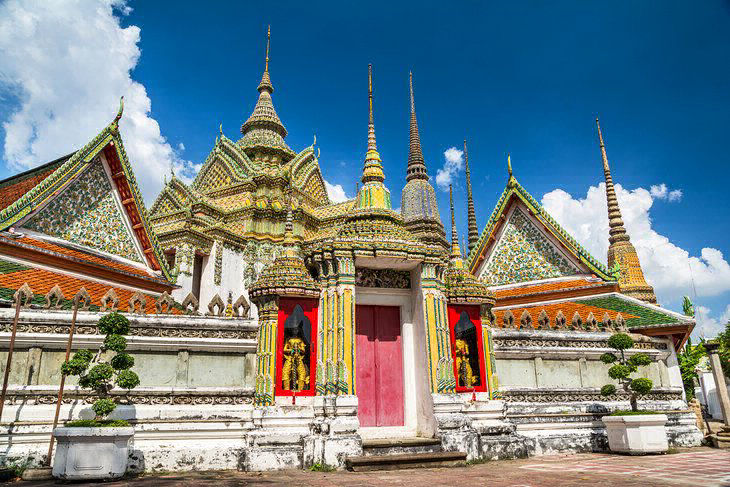
Wat Pho
Located just minutes away from the Grand Palace, Wat Pho (Wat Phra Chetuphon) is home to Thailand's largest reclining Buddha. At 46 meters long and 15 meters tall, the golden Buddha (literally covered in gold leaf) feels truly gigantic. The hall where the Buddha resides is covered in colorful murals and lined up with 108 bronze bowls.
Wat Pho is one of the oldest wats in the country, founded in Bangkok even before the city became the kingdom's capital. And while the hall where the reclining Buddha resides doesn't feel particularly large, the grounds of Wat Pho cover an area of over 80,000 square meters and include a number of chedis (stupas holding relics), praying halls, pavilions, formal gardens, and many life-size stone statues guarding the temple gates.
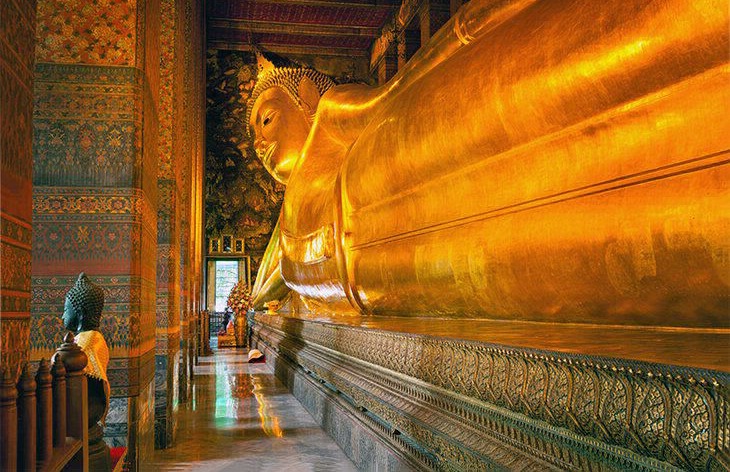
The Reclining Buddha
In addition to the stunning giant Buddha, Wat Pho is well known as the first public university of Thailand. While science and literature are no longer taught here, the temples do run a massage and natural medicine school. For visitors, that means Wat Pho is the perfect place to get a traditional Thai massage.
Hotels in Bangkok
Before you travel to Thailand, we recommend booking your hotel stay with Agoda to get the best deals and guaranteed lowest rates. Agoda will match any price on the web, or refund the difference. To check availability, prices and booking click on the banner below:
A Temple tour in Bangkok is a must-do because it will introduce you to Wat Pho, home of the Reclining Buddha, and Wat Phra Kaeo, otherwise known as The Temple of the Emerald Buddha. A Temple tour will also take you to Thailand’s foremost historical and cultural landmark, The Grand Palace...